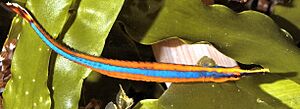Blue-striped pipefish facts for kids
Quick facts for kids Blue-striped pipefish |
|
|---|---|
 |
|
| Conservation status | |
| Scientific classification | |
| Genus: |
Doryrhamphus
|
| Species: |
excisus
|
| Subspecies | |
|
D. e. abbreviatus |
|
The Blue-striped pipefish (Doryrhamphus excisus) is a fascinating fish found in warm ocean waters. It's also called the blue-and-orange cleaner pipefish. This name comes from its bright colors and its special job of cleaning other sea creatures. You can find this pipefish swimming in many parts of the world, especially in the Indo-Pacific and tropical East Pacific oceans.
Contents
About the Blue-striped Pipefish
The Blue-striped pipefish was first described by a scientist named Johann Jakob Kaup in 1856. Sometimes, scientists divide a species into smaller groups called subspecies. These groups are slightly different and often live in different places.
- One subspecies, D. excisus abbreviatus, lives only in the Red Sea.
- Another, D. excisus paulus, is found near the Revillagigedo Islands in Mexico.
What Does It Look Like?
This pipefish is easy to spot because of its cool colors. It has a bright blue stripe running along its side. This stripe stands out against its orange or reddish body.
The Blue-striped pipefish also has a special tail that looks like a fan. Its tail fin, called a caudal fin, is rounded and has a white edge with a mostly black center. The fish also has a long, tube-like snout. Both male and female pipefish usually grow to about 7 centimeters (about 2.7 inches) long. You can tell males and females apart by their snouts:
- Males have small bumps and hooks on the top of their snout.
- Females have a smooth snout.
Where It Lives
The Blue-striped pipefish lives in many different places around the world. You can find it from the Persian Gulf all the way to the coasts of Central America and South America. It loves to live in coral reefs, hiding in small cracks and spaces. You might even spot them in shallow tide pools along the coast.
How It Behaves
Blue-striped pipefish are known for their helpful behavior. They often act as "cleaners" for bigger fish. They carefully inspect larger fish, looking for tiny parasites to eat. This is a special partnership where both animals benefit. The pipefish gets food, and the bigger fish gets rid of annoying parasites.
These pipefish often swim in pairs. They move in a wavy, up-and-down motion above the seafloor. This movement helps them attract larger fish that need cleaning. They have even been seen cleaning parasites off moray eels!
Pipefish Diet
The blue-and-orange cleaner pipefish eats tiny creatures. Its diet includes:
- Zooplankton: These are tiny animals that float in the water.
- Benthic invertebrates: These are small creatures that live on the seafloor.
- Parasites: These are tiny organisms that live on other fish.
The pipefish uses its long, tube-like snout like a vacuum cleaner. It quickly sucks in water to grab its food.
Pipefish Babies
When it's time to have babies, the female pipefish lays her eggs into a special pouch on the male's belly. This pouch is like a safe nursery. It has a special lining that gives the eggs oxygen and nutrients as they grow.
Keeping Them in Aquariums
Many people enjoy keeping Blue-striped pipefish in home aquariums. They are usually peaceful fish, especially when kept in pairs. Hobbyists have found success feeding them frozen foods like brine shrimp and mysis shrimp. In an aquarium, these pipefish often like to hang out in shady spots during the day. They have even been known to breed in captivity!


